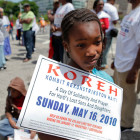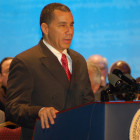Bronx
Tenants & Pols Protest Handling of Housing Vouchers
Eileen Markey |
It’s been six months since the New York City Housing Authority went back on a promise to help 2,600 low-income New Yorkers pay the rent. In that time 27 families that left the city’s shelters for homes of their own have returned to the shelters, homeless again, according to Judith Goldiner of the Legal Aid Society. And thousands who thought they had a life line are still waiting for help.Nilsa Melendez is one of them. The 44-year-old receptionist fled an abusive marriage and has been living in a shelter with her 14-year-old daughter since November 2008. In August 2009 she finally got a Section 8 rental assistance voucher.









